Pu’uhonua O Honaunau – Visiting Hawaii’s Place of Refuge
This is the final post of more than two dozen from a trip to the four major Hawaiian islands that Alison and I and friends took a few years ago. It has been updated for accuracy as of 2021. In the last post we visited Hawaii Volcanoes National Park and marvelled at the Big Island’s natural wonders. In this post we’ll visit Pu’uhonua O Honaunau formerly referred to a the Place of Refuge and learn more about Hawaii’s human history. But first, a bit about the Big Island’s second city Kailua-Kona. Please join us.
Of all the small cities we visited on the four islands of Hawaii, Kailua-Kona was by far our favourite. It has a great combination of natural beauty, Hawaiian history and just enough touristy things to do to make it exciting. Add the fact that because it is home to the world’s most famous triathlon, the Ironman, there are a lot of the most fit people you will see anywhere and that makes the place pretty unique, and I didn’t even mention the fishing or the coffee.
I got up early on another beautiful Hawaiian day, all memories of rainy Hilo and Volcano already forgotten and strolled just a few feet to the very tiny beach where the Ironman triathlon starts. On television the beach looks much larger as hundreds of participants plunge into the water to start one of the most grueling events ever invented in search of the elusive title of ‘Ironman’, emblematic of the best athlete on the planet. In reality the beach is probably no more than 150 feet across. Despite the fact the event was not for another six months there were a lot of people heading out to tackle the 2.4 mile swimming course that morning. I was surprised that more than a few were middle aged and even older. That’s the King Kamehameha Kona Hotel where we were staying in the background of the photo.
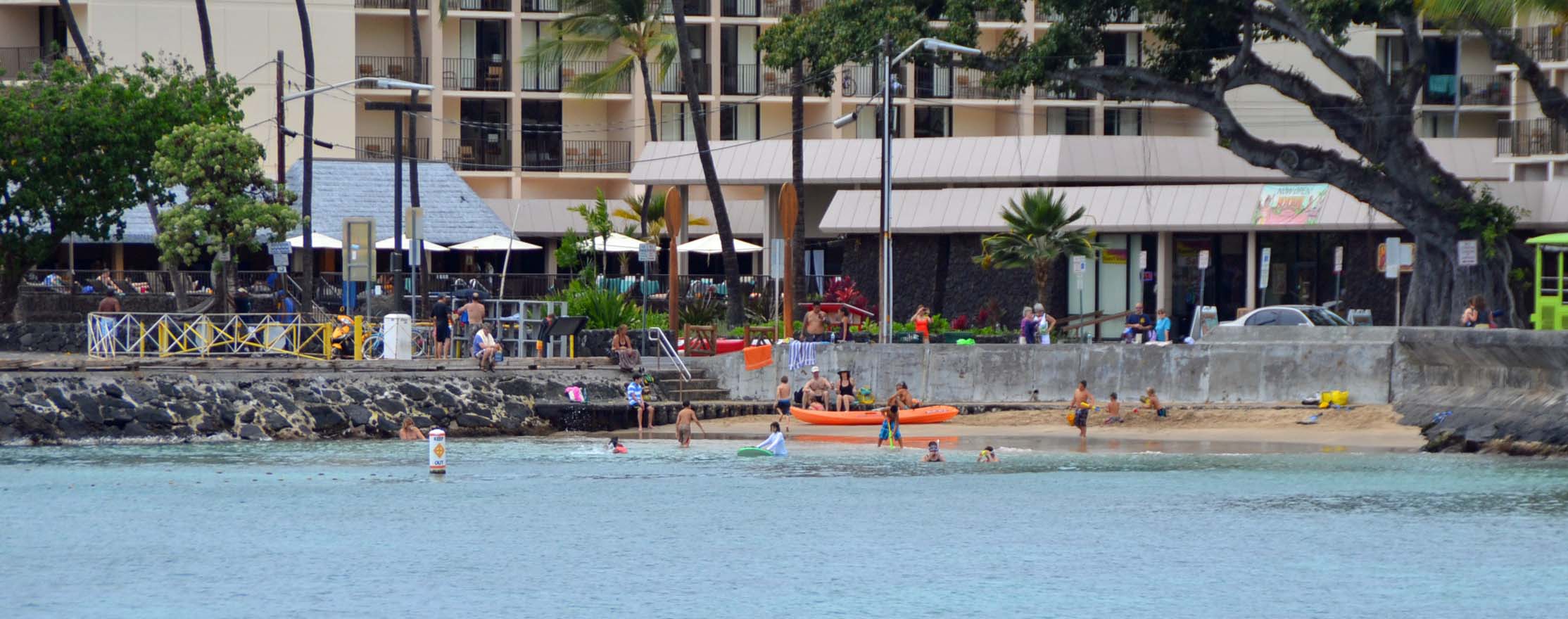
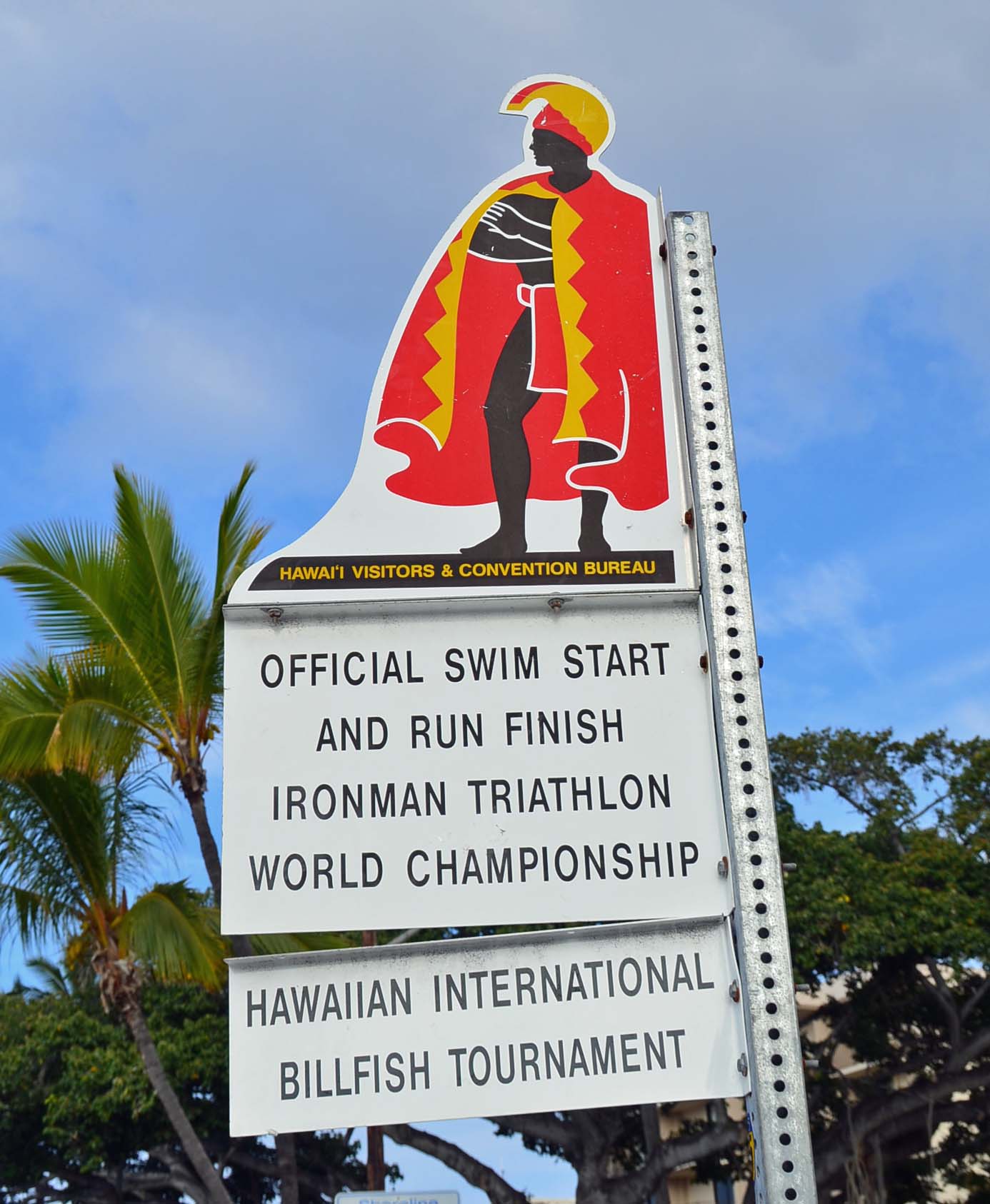
Over the next week wherever we went around Kona there were people who clearly were in training for the Ironman. It was not unusual to come across runners or cyclists out in the blistering midday heat on the highways that cut through desolate lava fields.
I crossed the street and grabbed a coffee at one of the many places offering Kona’s finest. You’d really have to be an idiot to go to a Starbucks in Kona, but they do exist. I continued along the waterfront past the handsome stone Mokuaikaua Church, the oldest in Hawaii and then by Hulihe’e Palace, summer home of a number of famous Hawaiian royalty, most notably David Kalakaua.
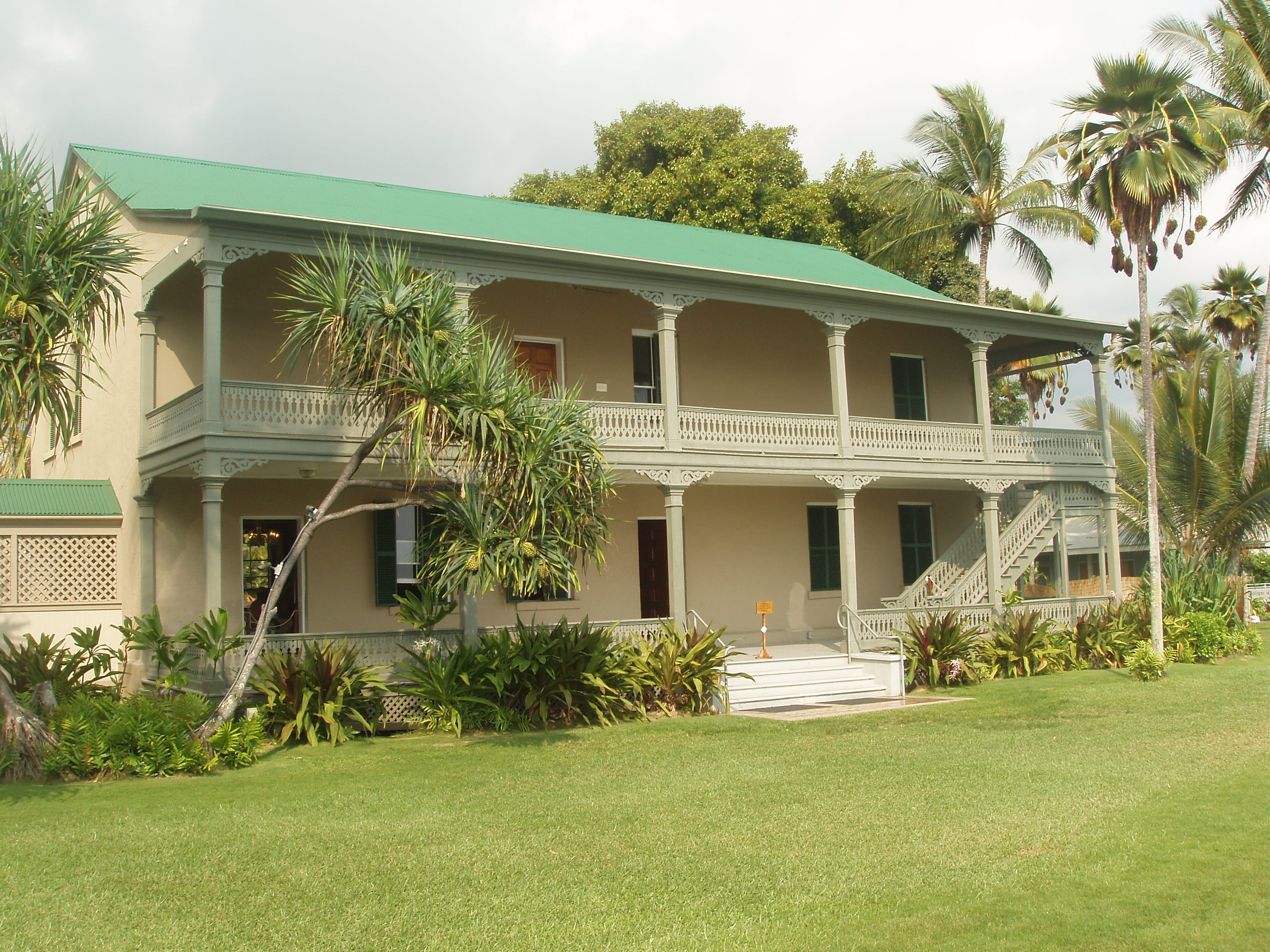
The coffee was great, the weather was perfect and it was a great day to be alive. Shortly we would be visiting a place where it literally was a great place just to be alive – Pu’uhonua O Honaunau or the Place of Refuge.
Pu’uhonua O Honaunau
Of all the Hawaiian islands, the Big Island is where we seemed to run into a greater number of native Hawaiians than elsewhere. We heard the native tongue spoken here almost everywhere we went. This was particularly true of our visits to the numerous native Hawaiian historical sites that dot the Kona coast where there were families of native Hawaiians communing with their past. This was also the coast from which Kamehameha the Great launched his conquest of the islands, uniting them under one monarchy that lasted for less than ninety years before being usurped by American commercial interests. Today we would explore one of the most famous Hawaiian historical sites Pu’uhonua O Honaunau National Historic Park or the Place of Refuge as it was once commonly referred to.
Returning from my morning reverie I picked up Alison, Rob and Janet and we headed south back through the coffee growing communities on the sides of Mauna Loa and down again to the ocean. Pu’uhanua O Honaunau is a National Historic Site on a beautiful oceanside setting on the south Kona coast. It was this ideal location on a small protected cove surrounded by black lava that led it to be chosen by Hawaiian royalty as both a place to rest after death and a place of refuge for those needing succour from a breach of any one of a myriad of petty taboos that required the death penalty.
Other than a few artifacts at the Bishop Museum in Honolulu, we had not come into contact with any of the darker sides of native Hawaiian life before the arrival of Westerners. It was not all hula dancing, luaus and surfing as we were about to find out here and at other places on the Kona coast over the next few days. After parking and paying the entry fee we learned the history of Pu’uhanua O Honaunau at the well designed and informative Interpretive Center. I was particularly impressed with this mosaic of a man being welcomed to Pu’uhonua O Honaunau after a clearly trying ordeal.
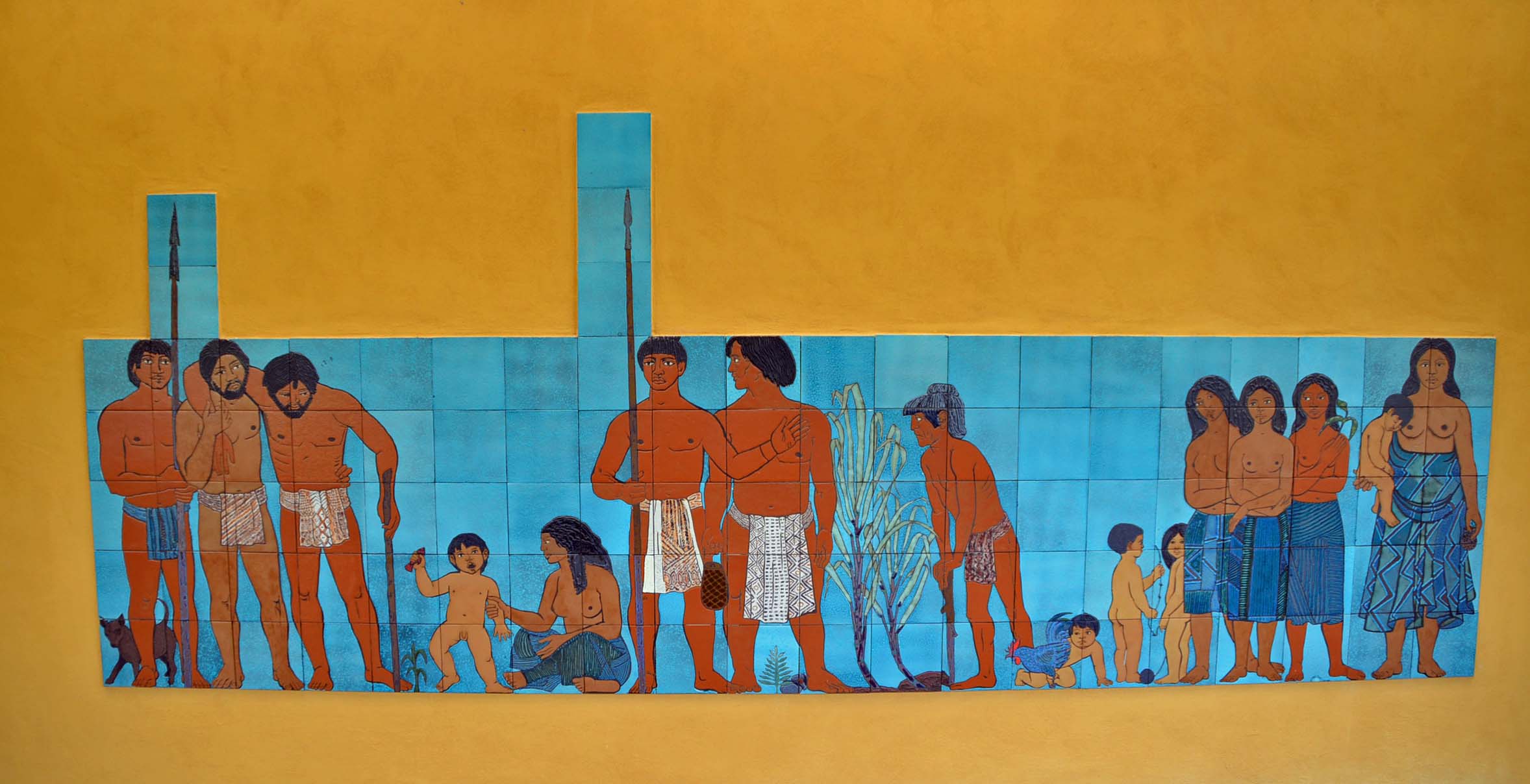
We learned that the Hawaiians, in the same manner as most other Polynesian peoples, had a a very strict code of rules and regulations that governed all aspects of life – kapu as they called it or taboo as most of us would recognize it. No matter what you called it, breaking it often meant immediate execution. There was only one way to avoid this and that was to try to get to one of the places of refuge that operated as sanctuaries where the king’s authority ended. The only problem was that there would probably be a howling mob chasing you either on foot or by canoe – a sort of real life version of The Hunger Game. If you did make it you most likely looked like the guy in the mosaic.
Pu’uhanua O Honaunau has a designated path that you can follow that will take you to the most important sites in the park and back to the Interpretive Center and we did just that. There were frequent signs that this was still considered a sacred place and the list of ‘don’t dos’ was pretty long. The first stop was the lovely small cove where Hawaiian royalty would land for their visits to the site, although the commoners wouldn’t know it because they were not allowed to even look at a person of nobility. If they did it was a breach of kapu and off with their heads.
Across the water there was an iconic view of what I had always assumed was the Place of Refuge. I blame this squarely on the United States Postal Service for portraying it as such on a stamp and misleading millions.
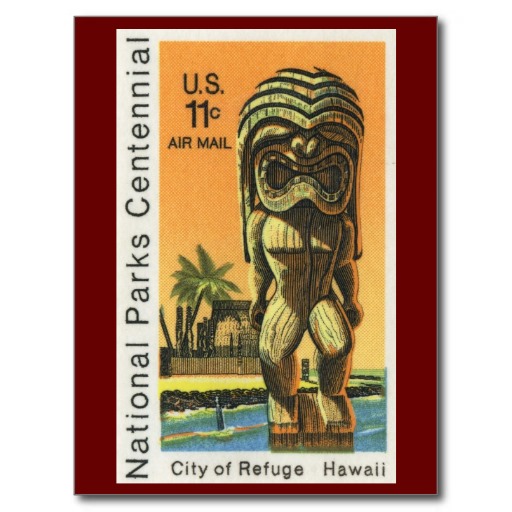
You can clearly see that the building in the background is the same as the building in this picture I took that morning.
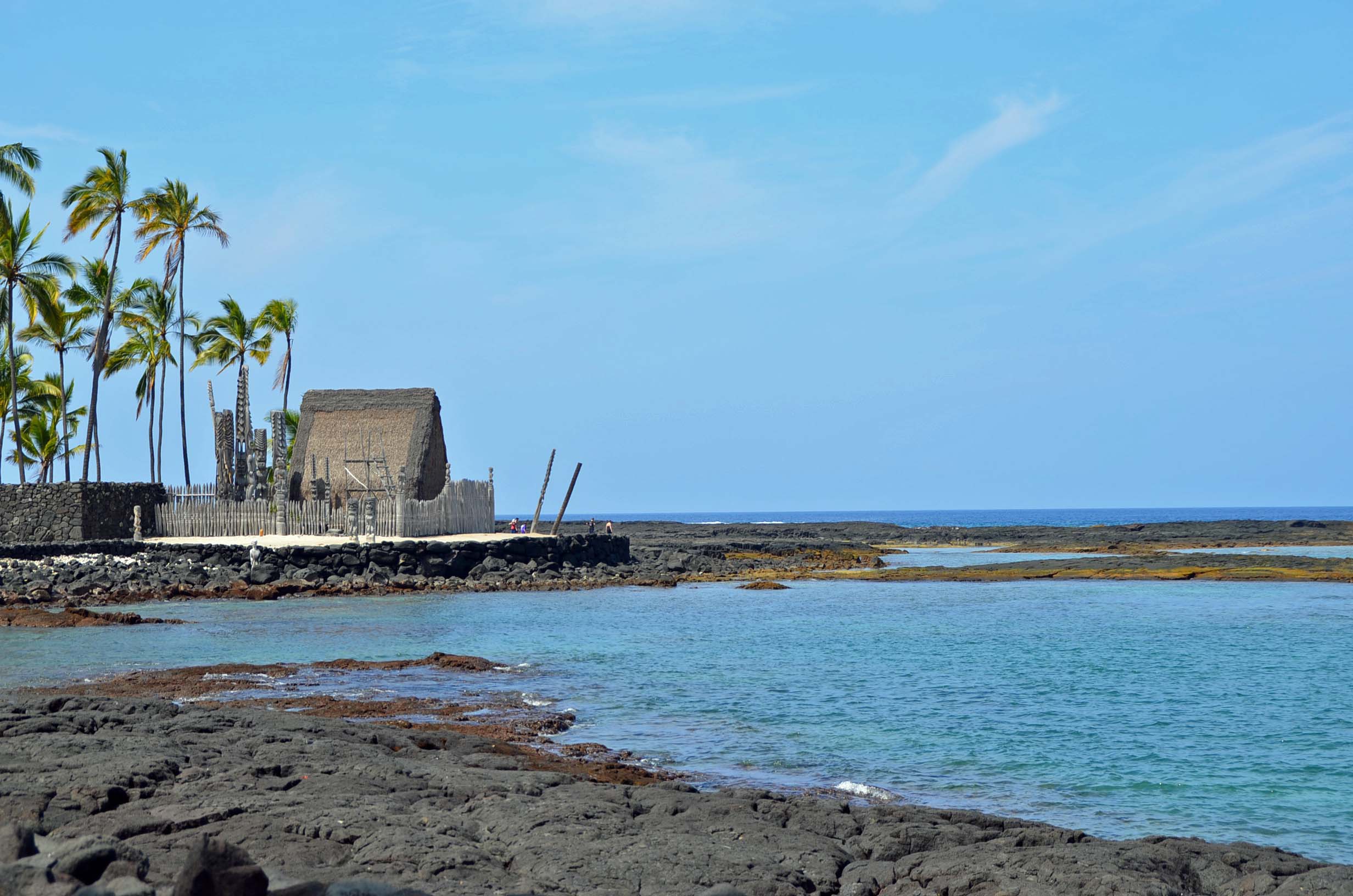
This is actually Hale O Keawe which is the heiau where the bones of ancient kings were interred and a place totally off limits to any but a few high priests and nobles. Here is a print of how the place looked in 1823 so they did a pretty accurate job of reconstructing after the Christianized Queen Ka’ahumanu ordered it destroyed in 1829.
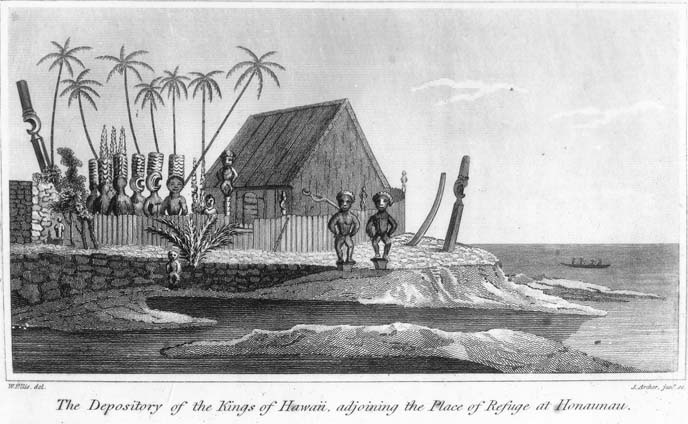
It bore a remarkable similarity to the reconstructed heiau in Kona that we had looked at from our dinner table the night before so I have to assume that like traditional Christian churches and mosques, that there is a general common architectural design for the ancient Hawaiian heiau.
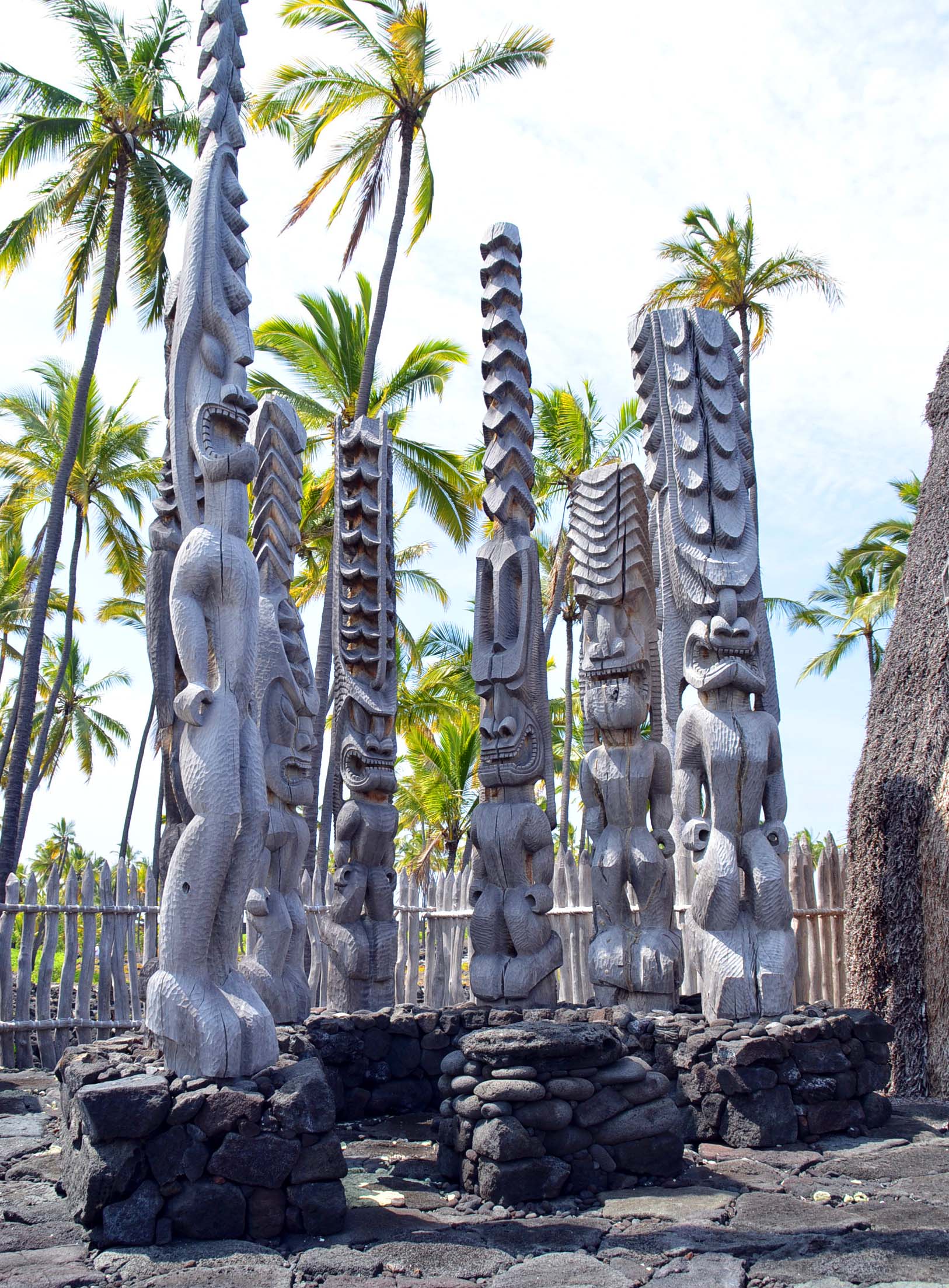
Despite being off limits to ordinary mortals we were allowed to approach the exterior and view the menacing carved statues or ki’i as the Hawaiians call them. We know them more commonly as tiki, as in tiki bar. They are meant to ward off evil spirits, but I can attest that it does not work on human beings. Despite the many prohibitions we saw none against tomfoolery and decided to engage in a little at the expense of the angry ki’is. We didn’t mean any disrespect, as we saw native Hawaiians doing the same thing.

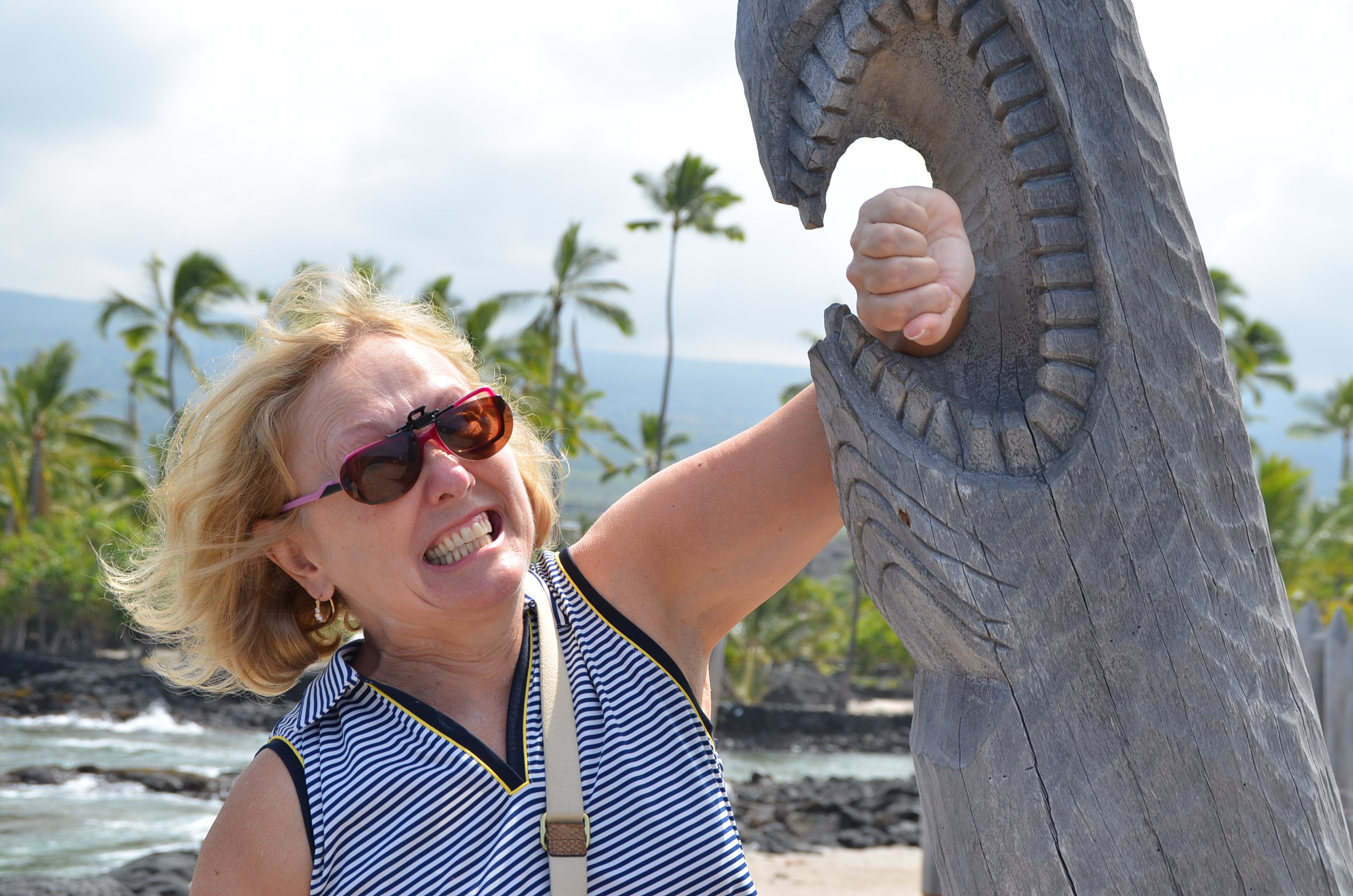
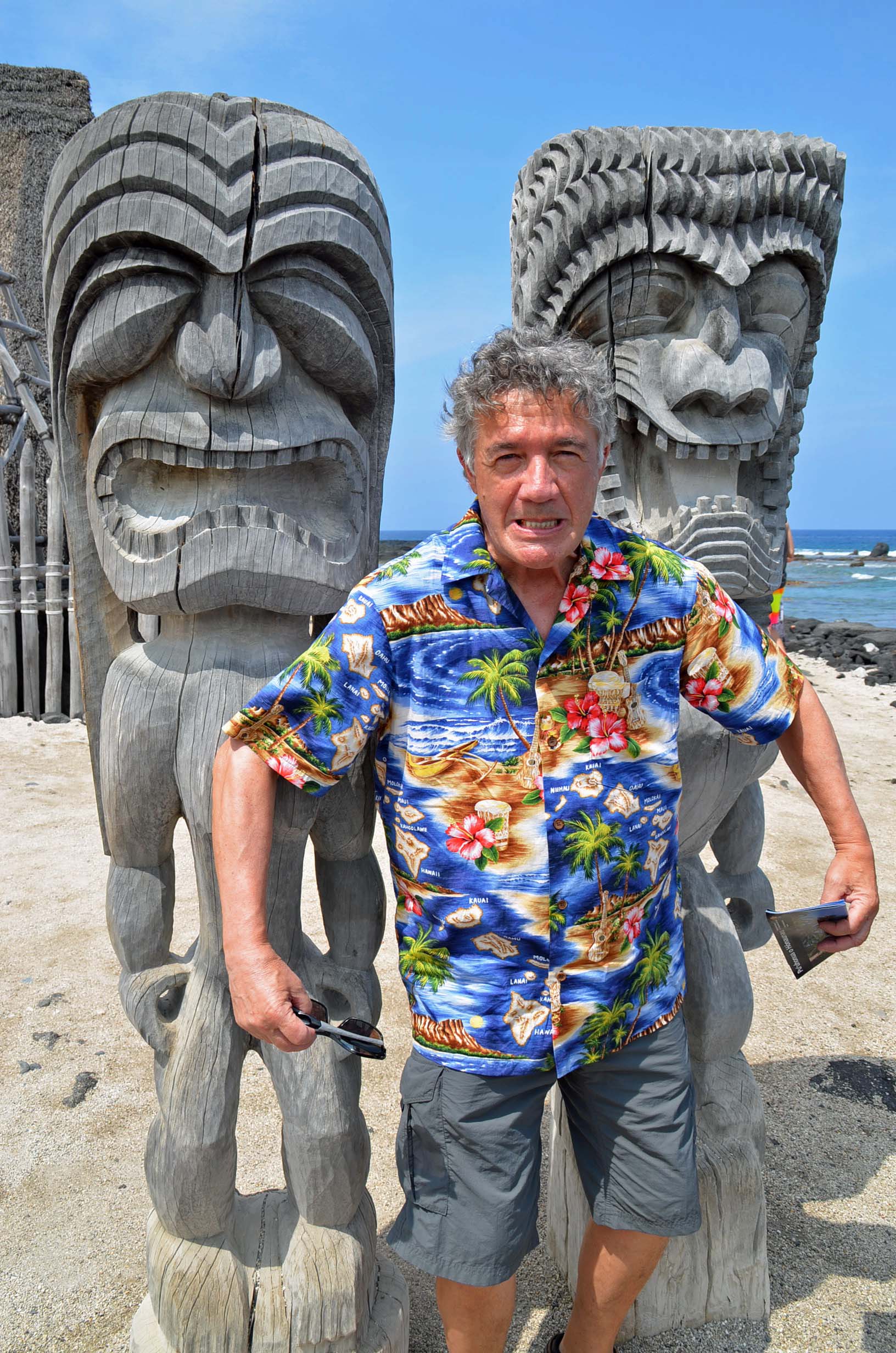
Just past Hale O Keawe we got our first closeup look at black lava that had flowed down from Mauna Loa and into the ocean centuries before at Pu’uhonua O Honaunau. It was quite different than the ejected lava we had seen at Kilauea and had many interesting patterns that almost looked like the fossils, the first one a trilobite and the second one petrified wood.
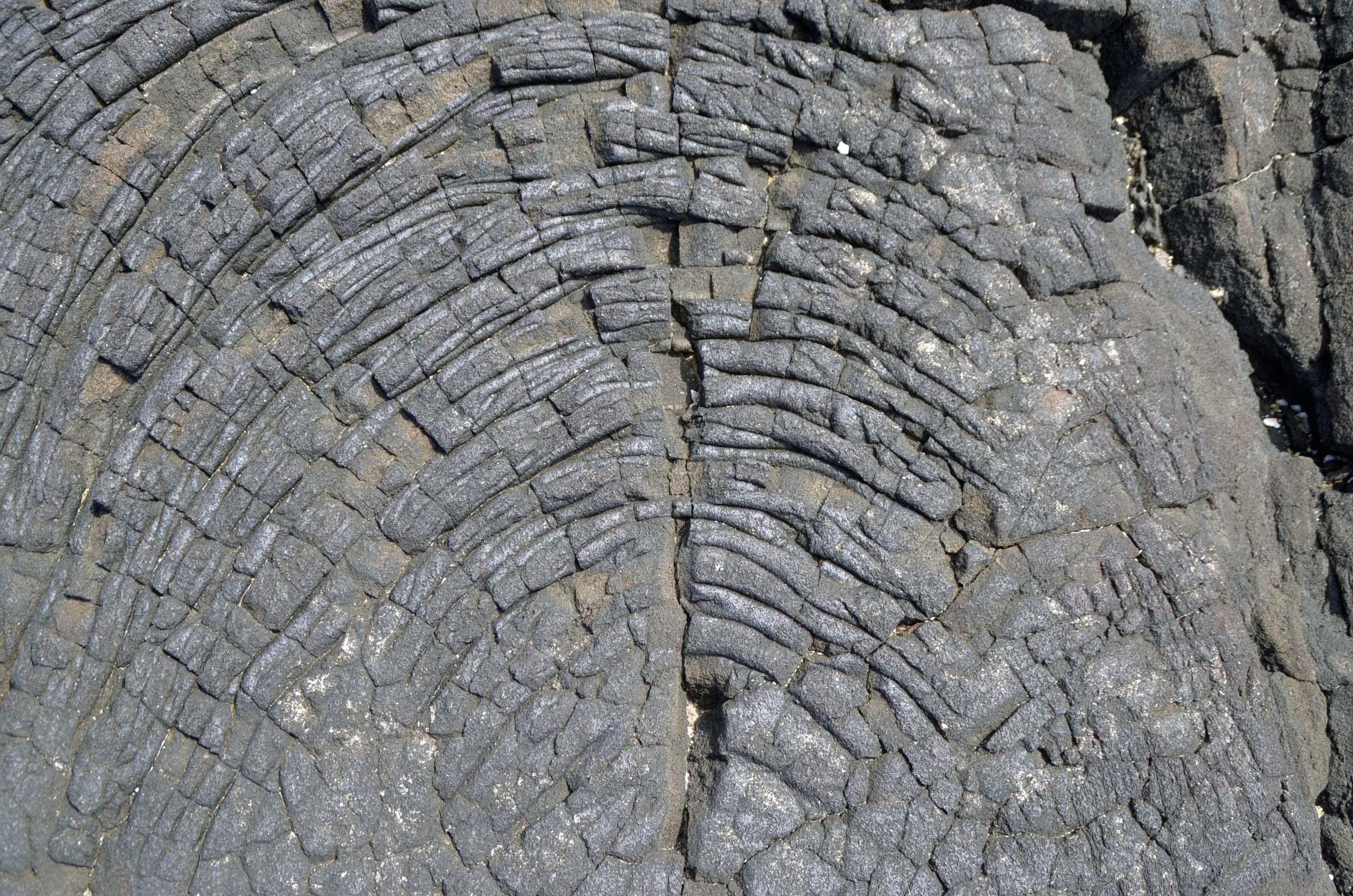
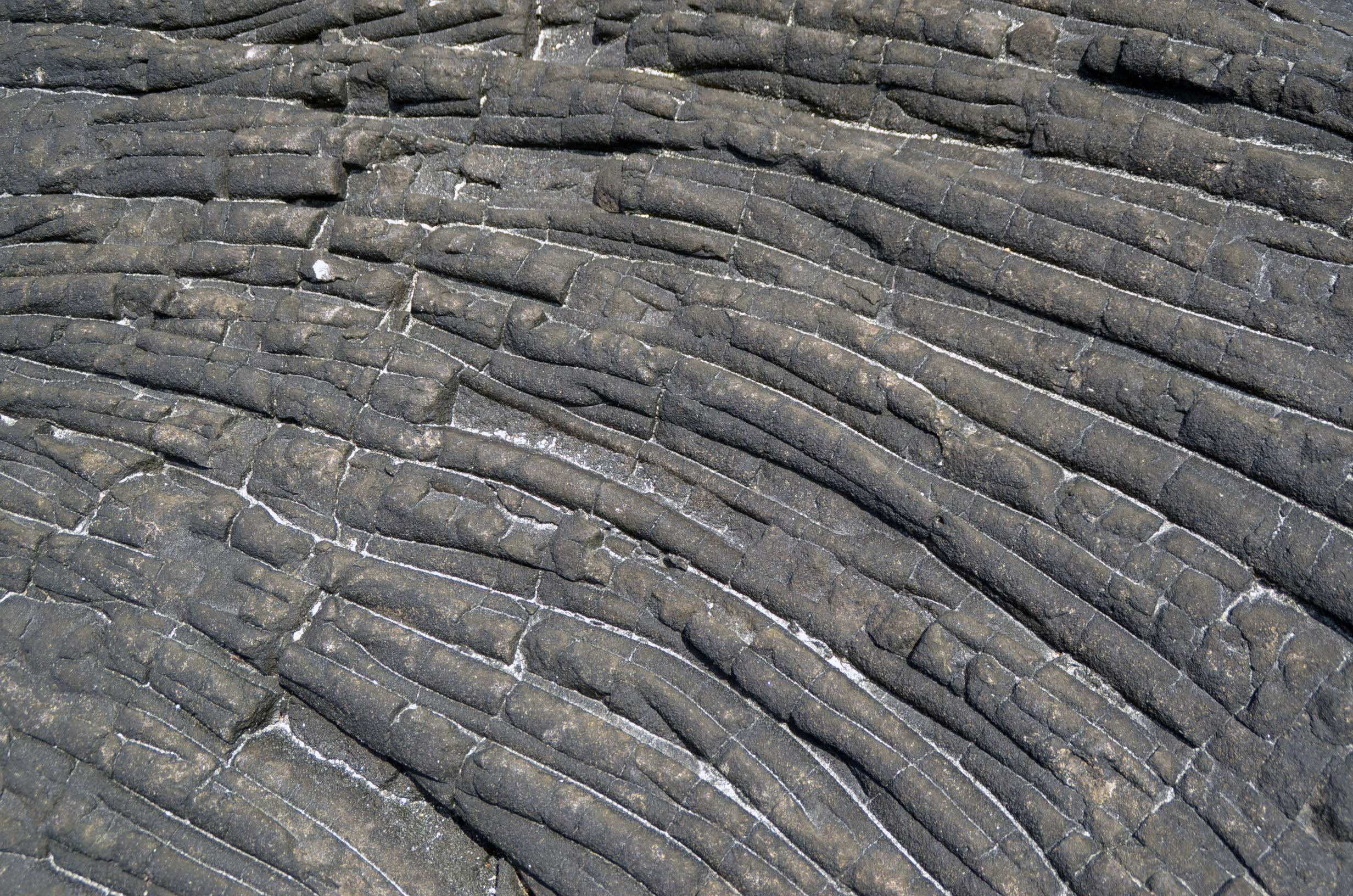
The lava at Pu’uhonua O Honaunau was pitted in many places with tidal pools that were fascinating to look at. We spent a good half an hour just going from pool to pool gazing into the crystal clear water, amazed at the number and variety of small fishes, crabs, shrimp and other sea life. This picture doesn’t do it justice, but it does show how clear the water was.
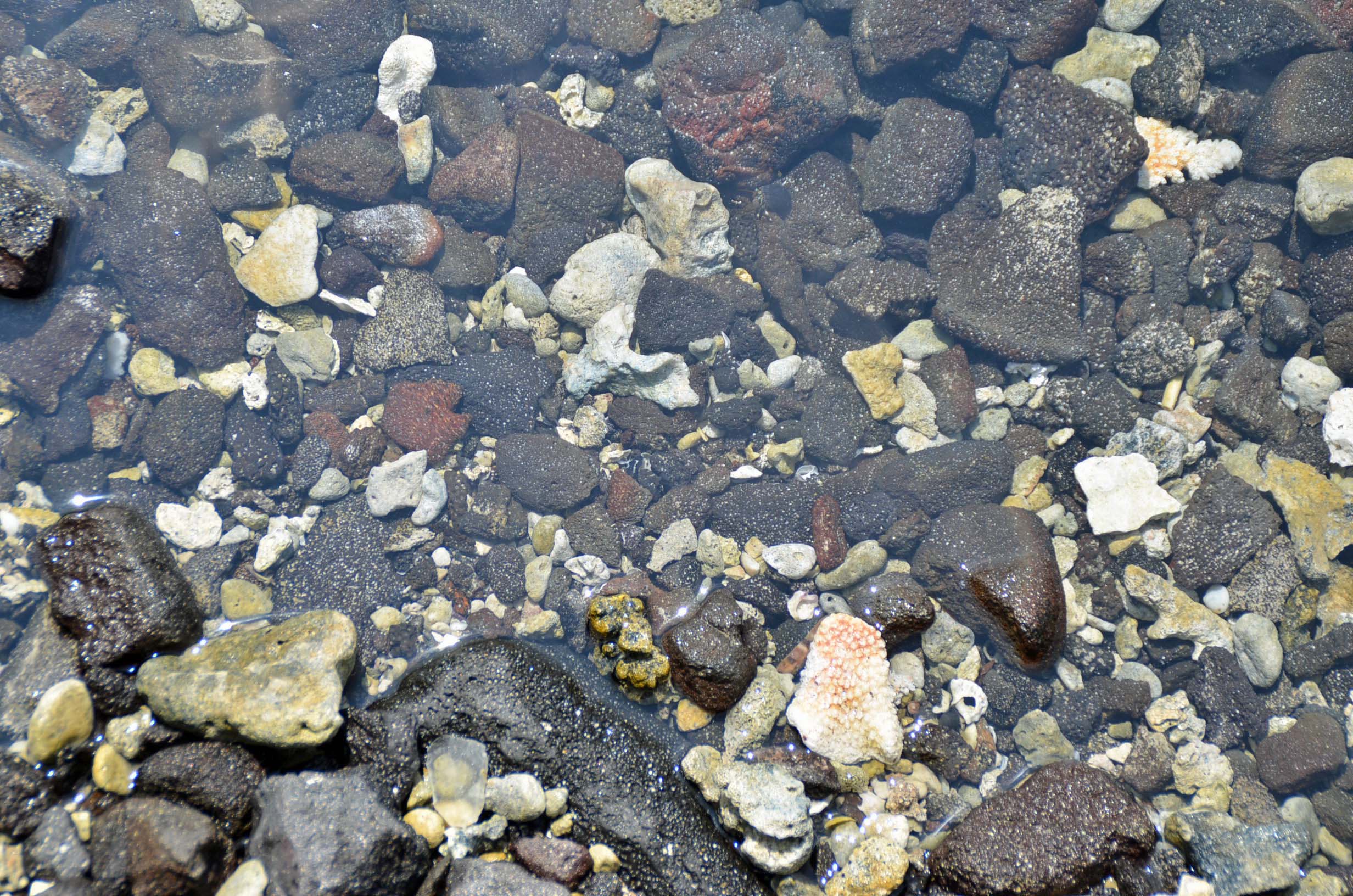
In addition to the lava patterns and the tide pools, the waves crashing into the shore at this spot put on quite a show. Janet, who is normally pretty safety conscious, went much closer to the on coming waves than I thought was prudent, but nothing untoward happened and it looks pretty cool in this photo.
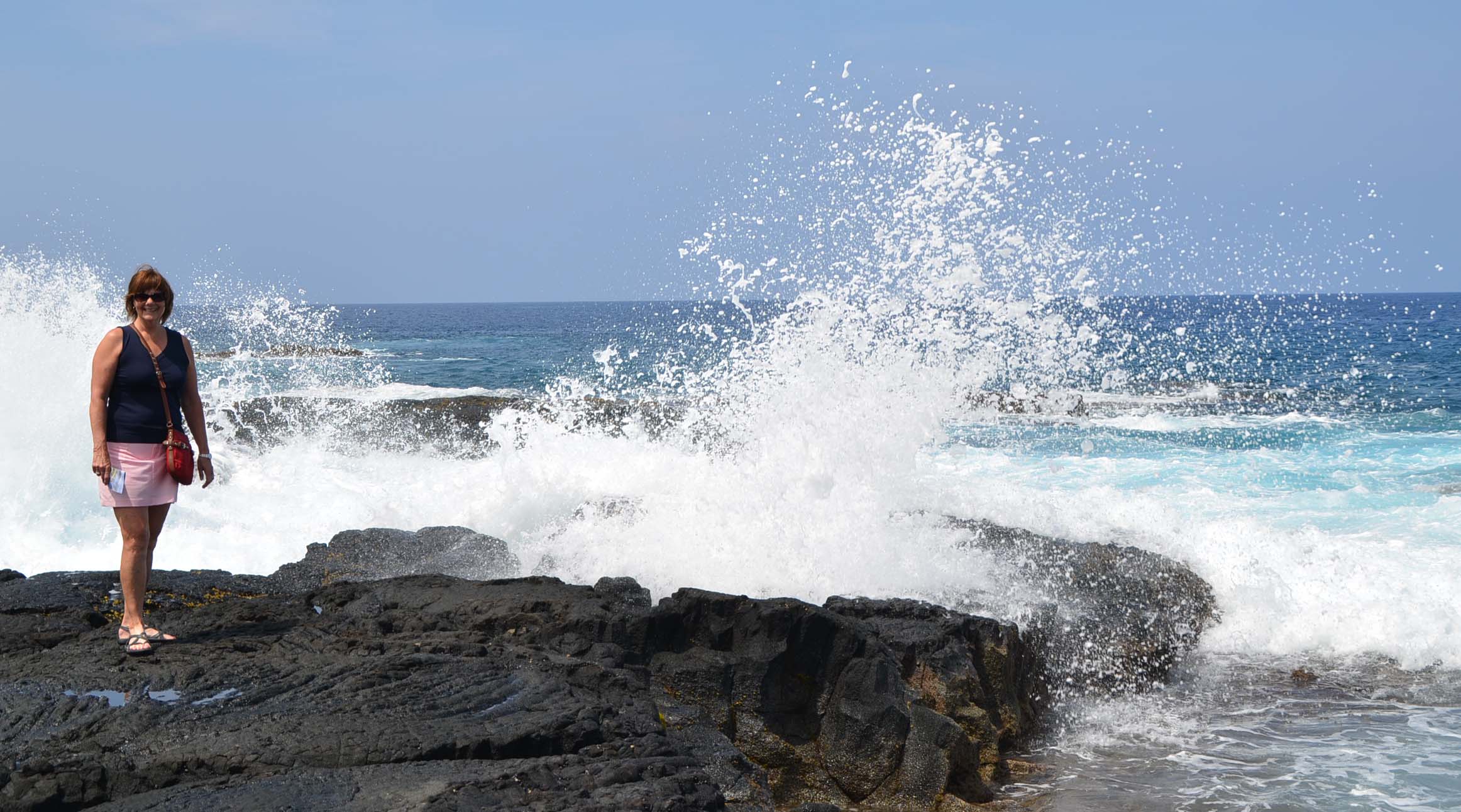
Even if Pu’uhanua O Honaunau did not have the historical significance it does, it would be worth visiting just to explore the seashore in the area. It is easy to see why the ancients pegged it as a site in which the gods took an interest.
So what about the Place of Refuge? Well actually it was right behind us on the shore.
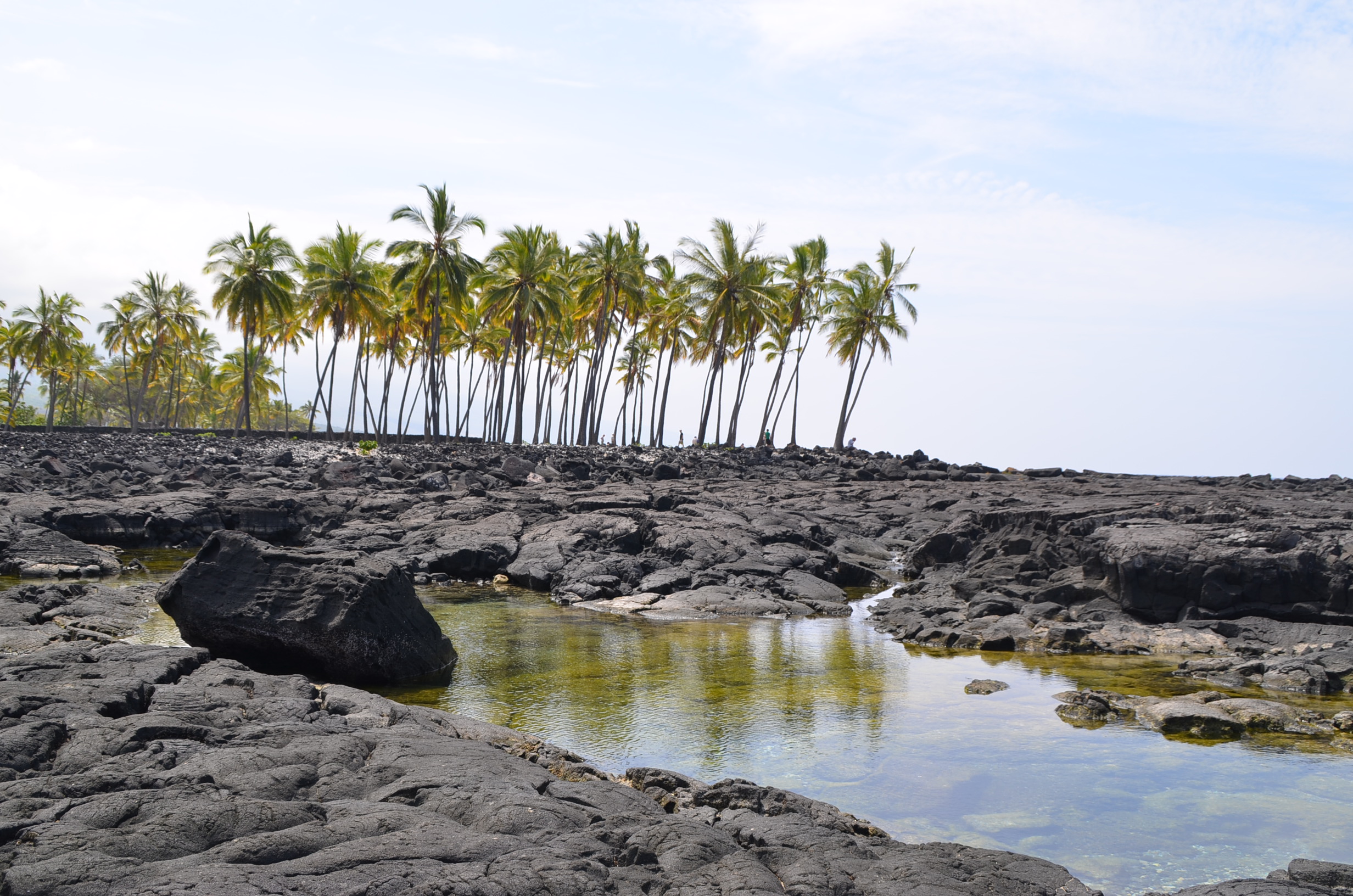
See the small line on the left of the palm trees – that’s actually a wall. Now pretend you have just landed and must run like hell to get there before your pursuers catch you. Assuming you make it, here’s what Pu’uhonua O Honaunau looks like close up, courtesy of the National Park Service.
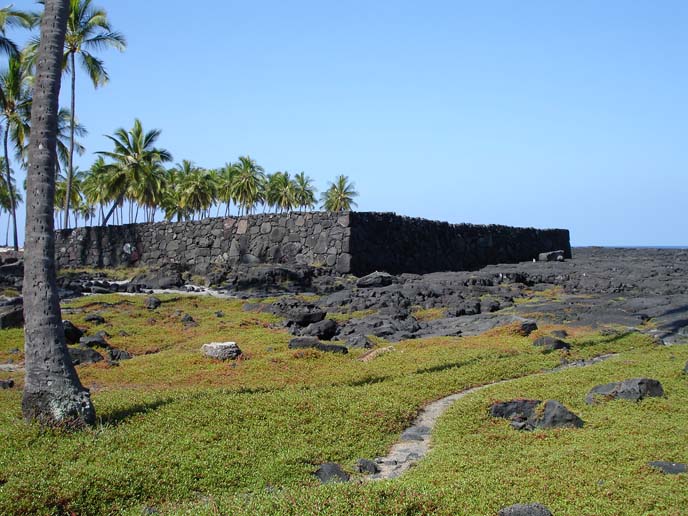
As you can see it’s more like a four walled prison than any place you might think of as giving refuge, but hey, when your heads on the line Lovelace’s observation that “stone walls do not a prison make” seems quite apt. Like Hale O Kewae the interior of Pu’uhonua O Honaunau is kapu.
We concluded our visit with a stop at the Royal Fishpond which is still in existence. These ponds were quite common in ancient Hawaii as a convenient place to store and raise fish exclusively for royal consumption. For the rest I guess it was a Hawaiian version of “let them eat cake”. After that we hit the road looking for a place to eat.
The little town of Kainalui looked pretty interesting so we stopped there and got out and hit the sidewalks. Instead of food we found donkey balls, (chocolate ones not the real thing) at a store on the main street that also had a great selection of coffee, macadamia nuts and other Hawaiian delicacies.
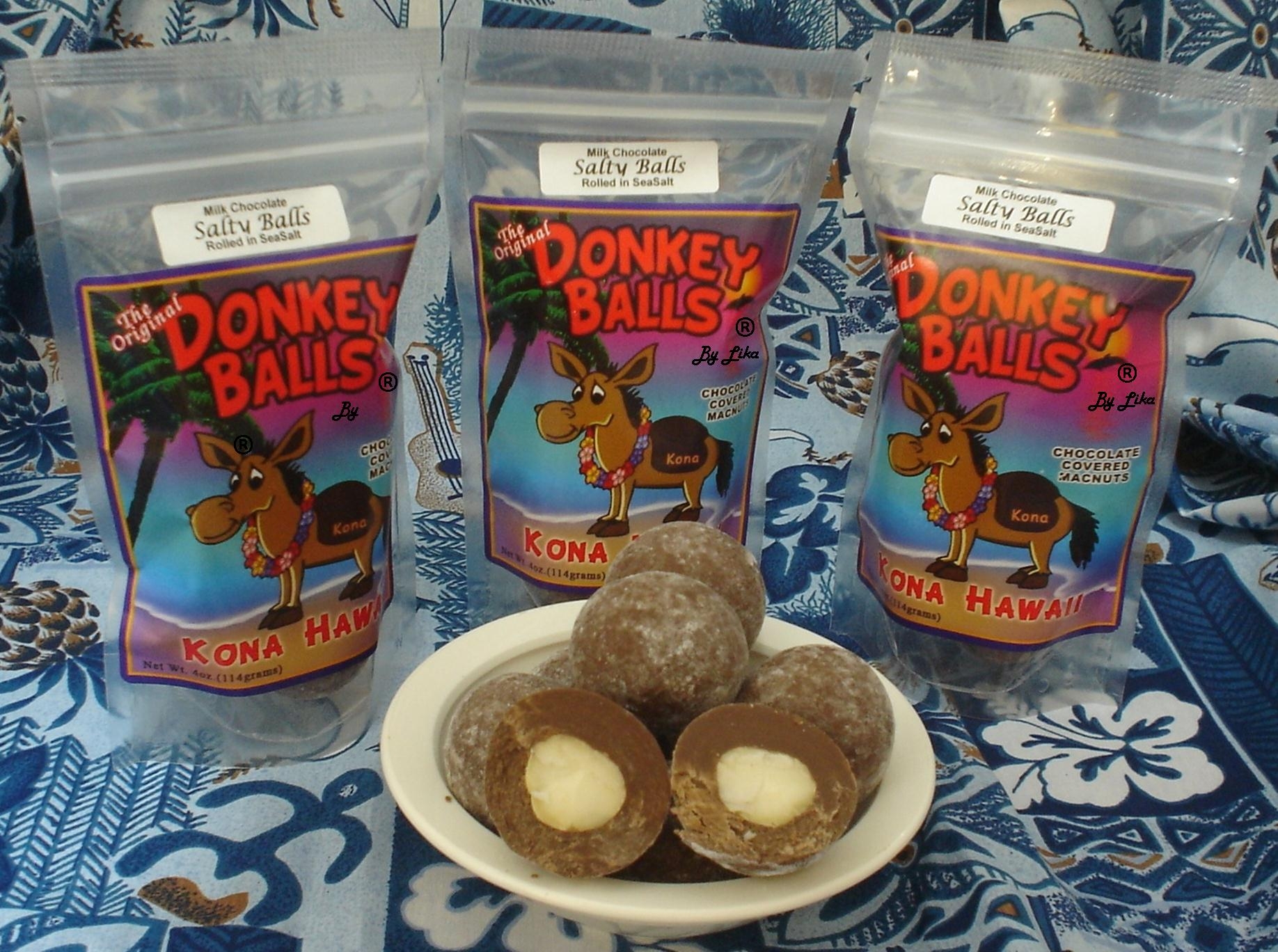
It was a great place to stock up on small gifts for friends and family back home. I also appreciated their weathervane.
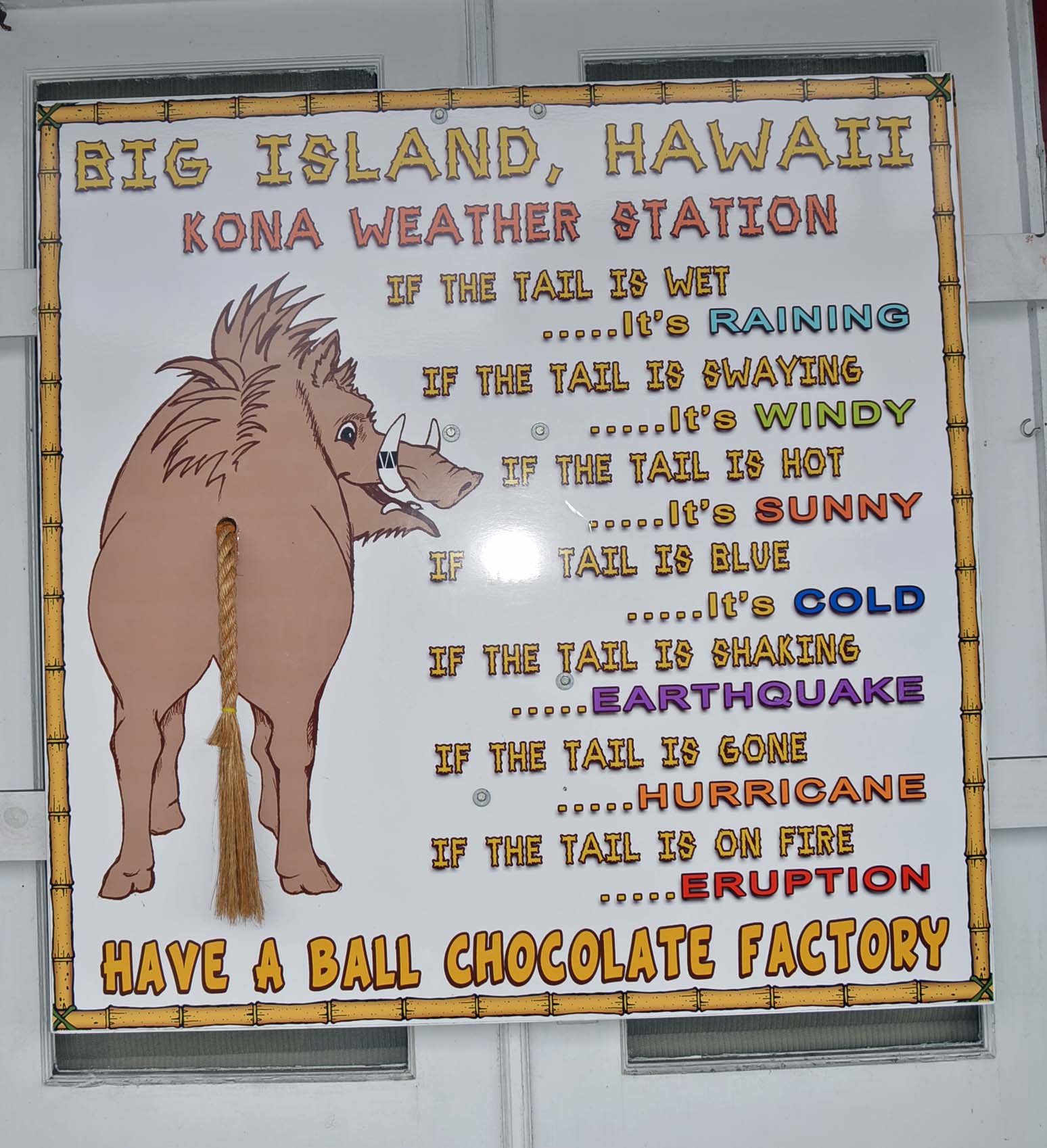
We did find some sandwiches and then I went in search of something I knew existed, but wasn’t sure where to look. Trust me, the traditional guidebooks on this one are out to lunch – not one had the proper facts.
I was looking for the monument to Captain Cook who I knew was killed at Kealakekua Bay in 1779. He has always had a special place for me, not only because he was an explorer of legendary renown, but because he had a close relationship with Atlantic Canada. He was stationed for a while in Halifax which he used as a base to map much of western Newfoundland’s coastline. I had traveled the trail named after him that runs from Corner Brook to Frenchman’s Cove and stood under his monument on Blow-me-Down Hill just outside the city; so I definitely wanted to see the monument at the place he was killed. I knew what the monument looked like from pictures and knew where it was on maps. A number of guidebooks clearly stated that you could drive to it, but I’ll be damned if I could find the road. There were no signs anywhere including even in the town of Captain Cook. People I asked were either tourists themselves or didn’t know.
Eventually I did find our way to Kealakekua Bay by way of a very steep, winding road that led down from the hillside towns to a very small community with lanes only wide enough for one vehicle. The road dead-ended at Kealakekua Bay. We left the car near what appeared to be a small park and headed out to look for the elusive monument. No dice. It turns out the alleged park was actually a heiau that was kapu to non-Hawaiians. I knew that from the signs.
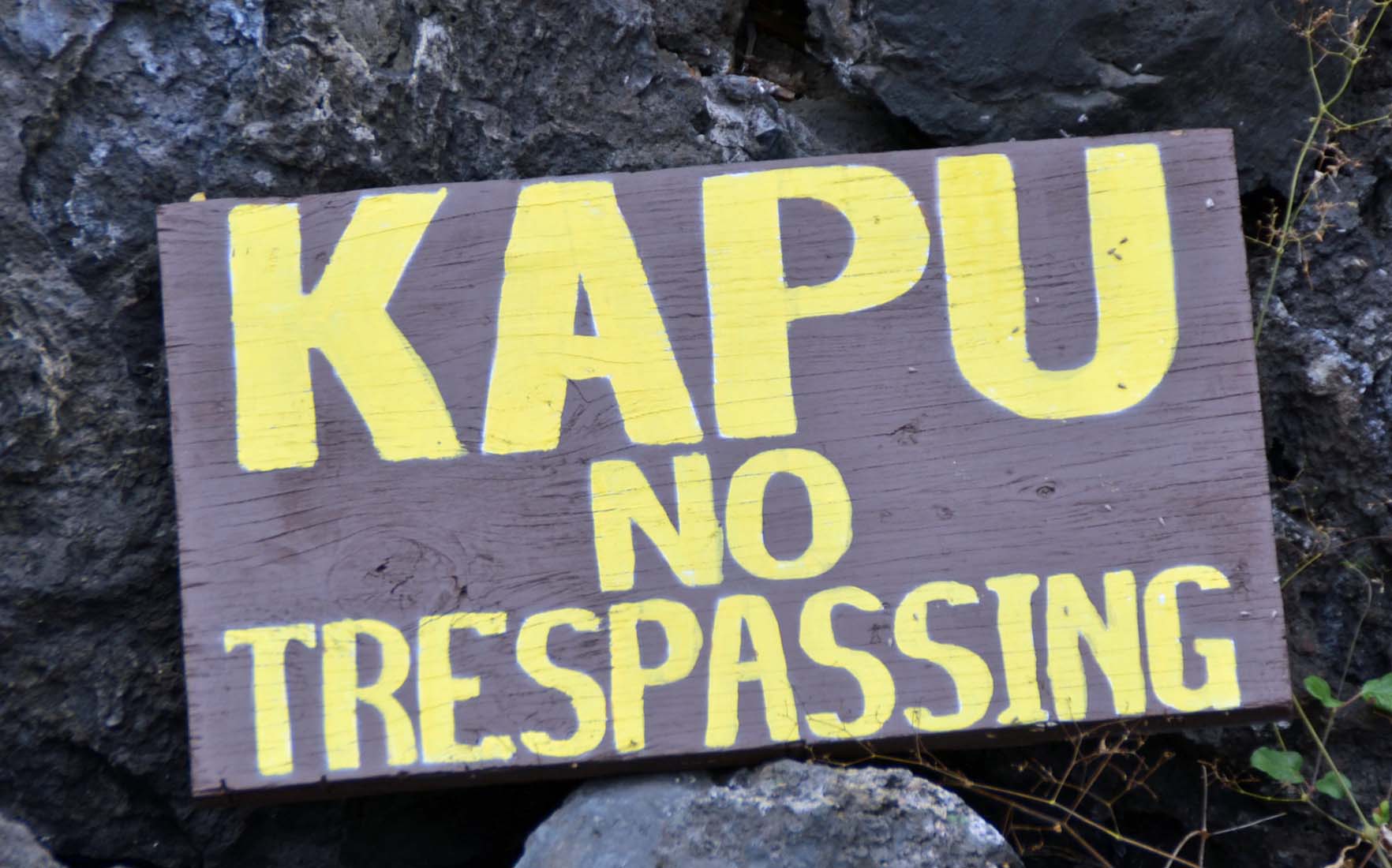
There were a few people on the beach which ended where the cliffs descended directly into the sea.
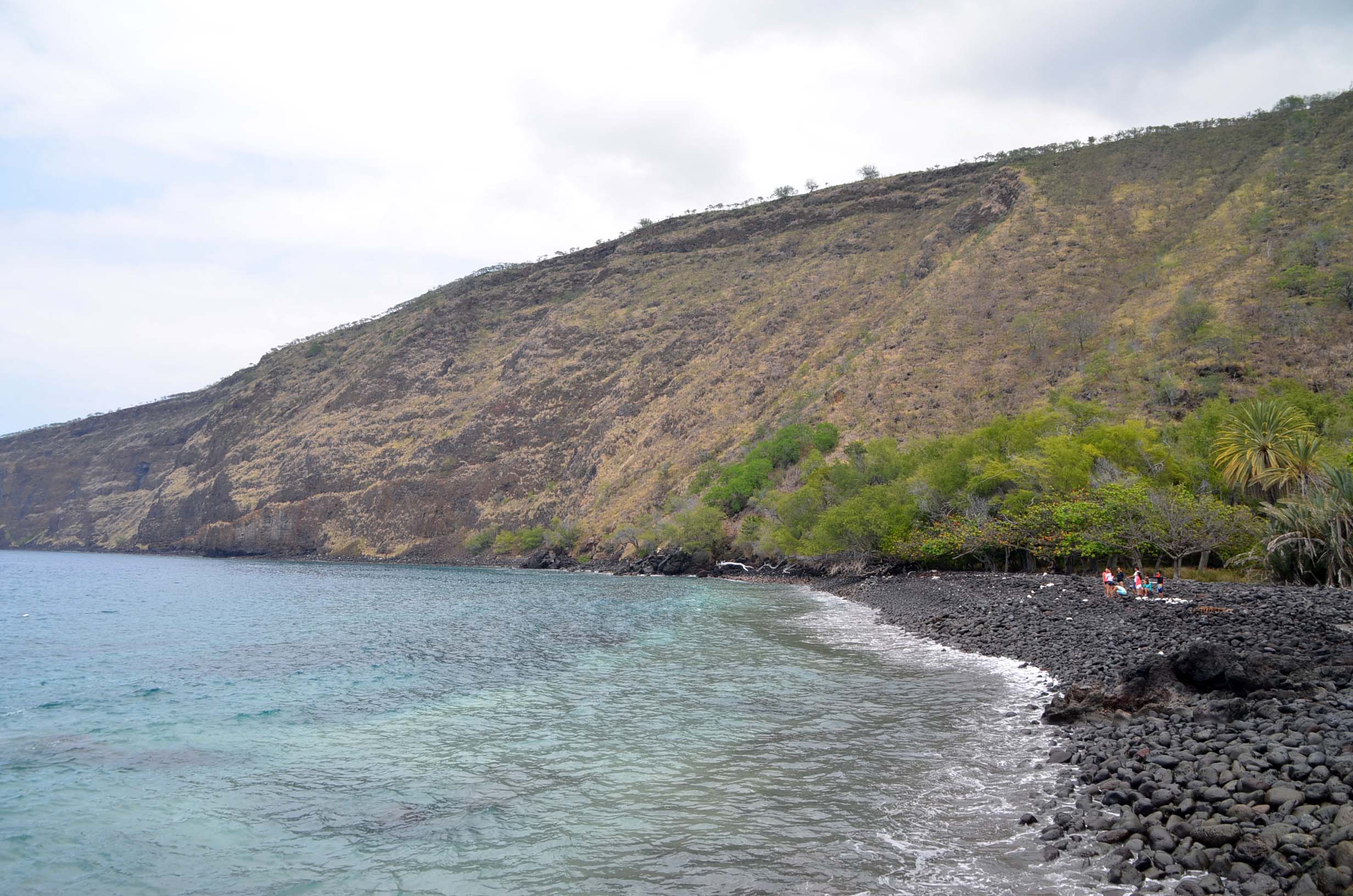
There was no monument in sight. Then I looked directly across the bay and there, about two miles away and completely inaccessible from where we were, was the monument. Son of a b****!
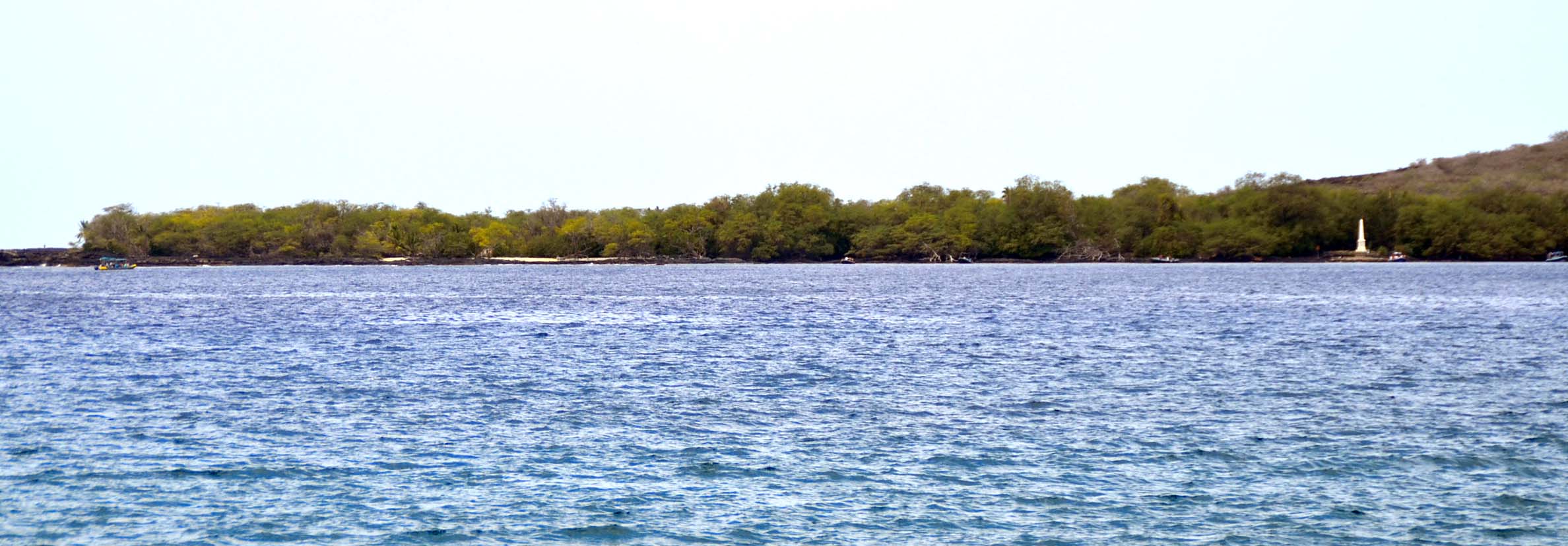
Well my plans had been foiled for today as it was actually getting a bit late, but like General MacArthur I vowed that “I will return.” I just needed another way.
We returned to Kona and had a quiet night, each couple dining on their own. We went to Quinn’s Almost by the Sea and I’m glad to say that for once when a restaurant claimed its signature dish was ‘famous’, this was justifiably so for their fish & chips made with ahi.
It had been a long day. Aloha from the Big Island.
Tomorrow we’ll go golfing with the peacocks at Makalei Golf Course. Please join us.

